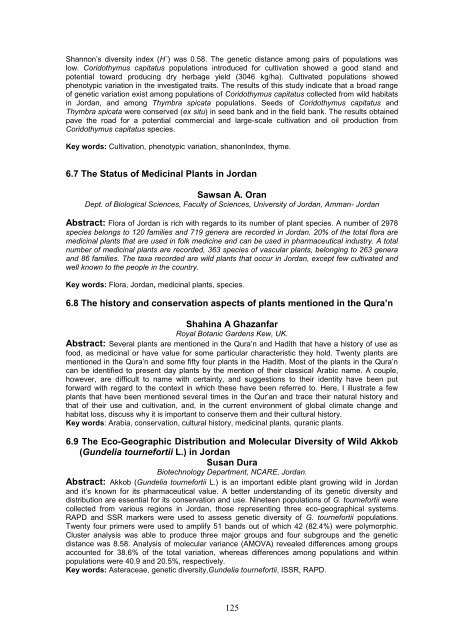Abstract Book - 3rd International Symposium on Medicinal Plants ...
Abstract Book - 3rd International Symposium on Medicinal Plants ...
Abstract Book - 3rd International Symposium on Medicinal Plants ...
You also want an ePaper? Increase the reach of your titles
YUMPU automatically turns print PDFs into web optimized ePapers that Google loves.
Shann<strong>on</strong>‟s diversity index (H`) was 0.58. The genetic distance am<strong>on</strong>g pairs of populati<strong>on</strong>s was<br />
low. Coridothymus capitatus populati<strong>on</strong>s introduced for cultivati<strong>on</strong> showed a good stand and<br />
potential toward producing dry herbage yield (3046 kg/ha). Cultivated populati<strong>on</strong>s showed<br />
phenotypic variati<strong>on</strong> in the investigated traits. The results of this study indicate that a broad range<br />
of genetic variati<strong>on</strong> exist am<strong>on</strong>g populati<strong>on</strong>s of Coridothymus capitatus collected from wild habitats<br />
in Jordan, and am<strong>on</strong>g Thymbra spicata populati<strong>on</strong>s. Seeds of Coridothymus capitatus and<br />
Thymbra spicata were c<strong>on</strong>served (ex situ) in seed bank and in the field bank. The results obtained<br />
pave the road for a potential commercial and large-scale cultivati<strong>on</strong> and oil producti<strong>on</strong> from<br />
Coridothymus capitatus species.<br />
Key words: Cultivati<strong>on</strong>, phenotypic variati<strong>on</strong>, shan<strong>on</strong>Index, thyme.<br />
6.7 The Status of <strong>Medicinal</strong> <strong>Plants</strong> in Jordan<br />
Sawsan A. Oran<br />
Dept. of Biological Sciences, Faculty of Sciences, University of Jordan, Amman- Jordan<br />
<str<strong>on</strong>g>Abstract</str<strong>on</strong>g>: Flora of Jordan is rich with regards to its number of plant species. A number of 2978<br />
species bel<strong>on</strong>gs to 120 families and 719 genera are recorded in Jordan. 20% of the total flora are<br />
medicinal plants that are used in folk medicine and can be used in pharmaceutical industry. A total<br />
number of medicinal plants are recorded, 363 species of vascular plants, bel<strong>on</strong>ging to 263 genera<br />
and 86 families. The taxa recorded are wild plants that occur in Jordan, except few cultivated and<br />
well known to the people in the country.<br />
Key words: Flora, Jordan, medicinal plants, species.<br />
6.8 The history and c<strong>on</strong>servati<strong>on</strong> aspects of plants menti<strong>on</strong>ed in the Qura’n<br />
Shahina A Ghazanfar<br />
Royal Botanic Gardens Kew, UK.<br />
<str<strong>on</strong>g>Abstract</str<strong>on</strong>g>: Several plants are menti<strong>on</strong>ed in the Qura‟n and Hadith that have a history of use as<br />
food, as medicinal or have value for some particular characteristic they hold. Twenty plants are<br />
menti<strong>on</strong>ed in the Qura‟n and some fifty four plants in the Hadith. Most of the plants in the Qura‟n<br />
can be identified to present day plants by the menti<strong>on</strong> of their classical Arabic name. A couple,<br />
however, are difficult to name with certainty, and suggesti<strong>on</strong>s to their identity have been put<br />
forward with regard to the c<strong>on</strong>text in which these have been referred to. Here, I illustrate a few<br />
plants that have been menti<strong>on</strong>ed several times in the Qur‟an and trace their natural history and<br />
that of their use and cultivati<strong>on</strong>, and, in the current envir<strong>on</strong>ment of global climate change and<br />
habitat loss, discuss why it is important to c<strong>on</strong>serve them and their cultural history.<br />
Key words: Arabia, c<strong>on</strong>servati<strong>on</strong>, cultural history, medicinal plants, quranic plants.<br />
6.9 The Eco-Geographic Distributi<strong>on</strong> and Molecular Diversity of Wild Akkob<br />
(Gundelia tournefortii L.) in Jordan<br />
Susan Dura<br />
Biotechnology Department, NCARE, Jordan.<br />
<str<strong>on</strong>g>Abstract</str<strong>on</strong>g>: Akkob (Gundelia tournefortii L.) is an important edible plant growing wild in Jordan<br />
and it‟s known for its pharmaceutical value. A better understanding of its genetic diversity and<br />
distributi<strong>on</strong> are essential for its c<strong>on</strong>servati<strong>on</strong> and use. Nineteen populati<strong>on</strong>s of G. tournefortii were<br />
collected from various regi<strong>on</strong>s in Jordan, those representing three eco-geographical systems.<br />
RAPD and SSR markers were used to assess genetic diversity of G. tournefortii populati<strong>on</strong>s.<br />
Twenty four primers were used to amplify 51 bands out of which 42 (82.4%) were polymorphic.<br />
Cluster analysis was able to produce three major groups and four subgroups and the genetic<br />
distance was 8.58. Analysis of molecular variance (AMOVA) revealed differences am<strong>on</strong>g groups<br />
accounted for 38.6% of the total variati<strong>on</strong>, whereas differences am<strong>on</strong>g populati<strong>on</strong>s and within<br />
populati<strong>on</strong>s were 40.9 and 20.5%, respectively.<br />
Key words: Asteraceae, genetic diversity,Gundelia tournefortii, ISSR, RAPD.<br />
125

















